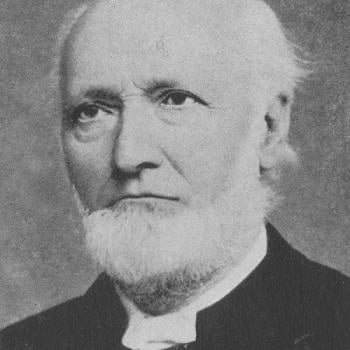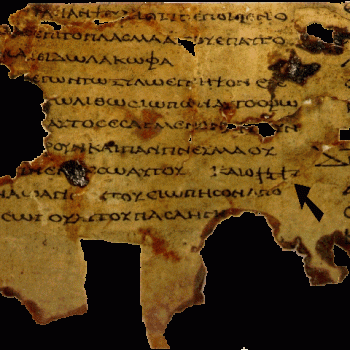
Atheist and anti-theist Bob Seidensticker runs the influential Cross Examined blog. He asked me there, on 8-11-18: “I’ve got 1000+ posts here attacking your worldview. You just going to let that stand? Or could you present a helpful new perspective that I’ve ignored on one or two of those posts?” He also made a general statement on 6-22-17: “In this blog, I’ve responded to many Christian arguments . . . Christians’ arguments are easy to refute.” He added in the combox: “If I’ve misunderstood the Christian position or Christian arguments, point that out. Show me where I’ve mischaracterized them.” I’m always one to oblige people’s wishes, so I decided to do a series of posts in reply.
It’s also been said, “be careful what you wish for.” If Bob responds to this post, and makes me aware of it, his reply will be added to the end along with my counter-reply. If you don’t see that at the end, rest assured that he either hasn’t replied, or didn’t inform me that he did. Bob’s words will be in blue. To find these posts, word-search “Seidensticker” on my atheist page or in my sidebar search (near the top).
*****
In his post, “The Ridiculous Argument from Accurate Names” (6-12-18; update of the original, dated 9-22-14), Bob stated: “Archaeology says that the Exodus didn’t happen.” Many archaeologists say there is little or no archaeological evidence, it’s true. There are plenty of biblical skeptics (not just atheists) and those who wrongly think that the Bible is an unreliable document for historiographical purposes. But it’s difficult to make an absolute statement like this in archaeology and other sciences.
Even if someone said, “we have not yet found any archaeological evidence for the Exodus,” that’s not logically the same as claiming that “the Exodus didn’t happen.” The latter is a far stronger, and far more skeptical claim. Seidensticker (an intelligent and educated man) should know better than that, but his strong anti-Christian bias precludes care and precision in his grandiose claims.
I submit that there is at least some evidence from history and archaeology. It’s not totally absent. Of course most if not all of the evidence is for only parts of the biblical story: verifying it, etc. But if it’s consistent with the story, it is some sort of corroborating evidence. I shall now present some of this for your consideration (links with some quotations):
1) Israel in Egypt: The Evidence for the Authenticity of the Exodus Tradition (James K. Hoffmeier, Oxford University Press, revised edition: 18 March 1999).
Abstract: Scholars of the Hebrew Bible have in the last decade begun to question the historical accuracy of the Israelite sojourn in Egypt, as described in the book of Exodus. The reason for the rejection of the exodus tradition is said to be the lack of historical and archaeological evidence in Egypt. Those advancing these claims, however, are not specialists in the study of Egyptian history, culture, and archaeology. This book examines the most current Egyptological evidence and argues that it supports the biblical record concerning Israel in Egypt.
Reviews: “This is historical research at its best, with constant attention to primary sources…[Hoffmeier] retains a broad perspective and leaves no stone unturned in his quest to have the epigraphic and archeological evidence shed light on the biblical record of Israel’s sojourn in and exodus from Egypt.”–Gary Rendsburg, Cornell University
“Israel in Egypt is one of those rare works that one cannot read without taking notes on nearly every page. For biblical scholars, who are seriously interested in the Exodus and the issues revolving around the historicity of the Bible, especially regarding the origins of Israel, Israel in Egypt could not be more highly recommended.”–Near East Archaeological Society Bulletin
“This volume is a bold and important attempt to infuse the current debate with a reasoned appraisal of biblical, archaeological, and philological evidence. Hoffmeier is uniquely qualified to make such an attempt because he is one of the few scholars who can handle both the Egyptian evidence and the biblical materials.”–Asbury Theological Journal
“This volume will become a classic text for a positive and conservative evaluation of the literary and archaeological evidence for the ‘historicity’ of the Israelites in Egypt.”–Walter D. Zorn, Lincoln Christian College and Seminary
“This well-presented case brims with the type of knowledge most never bother to attain.”–J. Julius Scott, Wheaton College
“The best and most good-spirited defense yet of the conservative position that takes the Biblical “Exodus-Conquest” narratives literally as history.”–William G. Dever, University of Arizona
“Hoffmeier’s study represents the fruit of many years of study in Egyptology and the Old Testament. The work is a substantial contribution to the ongoing discussion on the subject of Israel’s presence in Egypt and represents a view that is in harmony with an appreciation of the Bible as a valuable historical source….This is an excellent volume for introducing the subject it covers.”—Denver Journal
“Hoffmeier’s book is an important contribution to the study of the Hebrew experience in Egypt. Its two major strengths are the author’s powerful refutation of hyper-critical views on the narrative and his presentation of the latest Egyptological data.”–Journal of the Evangelical Theological Society
James K. Hoffmeier (PhD, University of Toronto), has taught at the undergraduate and graduate levels for more than thirty years, and is professor of Old Testament and Near Eastern archaeology at Trinity International University. He was born and raised in Egypt.
2) “The Exodus Controversy” (Associates for Biblical Research, 2002):
Limits of Archaeology
Many critics who doubt the historicity of the Exodus share a problem: over-reliance on what archaeology can prove. Archaeology is, in fact, a limited and imperfect area of study in which the interpretation of findings, as archaeologists readily admit, is more of an art than a hard science.
Archaeologist Edwin Yamauchi points out the limits of this science when he explains:
(1) little of what was made or written in antiquity survives to this day;
(2) few of the ancient sites have been surveyed and a number have not even been found;
(3) probably fewer than 2 percent of the known sites have been meaningfully excavated;
(4) few of these have been more than scratched; and
(5) only a fraction of the fraction that have been excavated have been published and data made available to the scholarly world (1972: chapter 4).
Considering not only the limits but also the positive side of archaeology, it is remarkable how many Biblical accounts have been illuminated and confirmed by the relatively small number of sites excavated and finds uncovered to date. Even though, regrettably, some professionals go out of their way to present a distorted picture of what archaeology does reveal, it does provide some of the strongest evidence for the reliability of the Bible as credible and accurate history. . . .
3) “The Exodus Is Not Fiction: An interview with Richard Elliott Friedman” (ReformJudaism.org):
Richard Elliott Friedman, who holds a Th.D from Harvard, is the Ann and Jay Davis Professor of Jewish Studies at the University of Georgia and the Katzin Professor of Jewish Civilization Emeritus of the University of California, San Diego, and was a visiting fellow at Cambridge and Oxford and a Senior Fellow of the American Schools of Oriental Research in Jerusalem. He is the author of seven books, including the bestselling Who Wrote the Bible? and Commentary on the Torah. . . .
[Y]our readers may have concluded that scholarship shows that the Exodus is fictional, when, in fact, that is not so. There is archaeological evidence and especially textual evidence for the Exodus. . . .
At a recent international conference entitled “Out of Egypt” on the question of the Exodus’ historicity, one point of agreement, I believe, among most of the 45 participating scholars was that Semitic peoples, or Western Asiatics, were in fact living in Egypt and were traveling to and from there for centuries. And the evidence indicates that the smaller group among them, who were connected with the Exodus, were Levites. The Levites were members of the group associated with Moses, the Exodus, and the Sinai events depicted in the Bible. In the Torah, Moses is identified as a Levite. Also, out of all of Israel only Levites had Egyptian names: Moses, Phinehas, Hophni, and Hur are all Egyptian names. . . .
[T]he architecture of the Tabernacle and its surrounding courtyard matches that of the battle tent of Pharaoh Rameses II, for which we have archaeological evidence, as was shown by Professor Michael Homan in a brilliant combination of archaeology and text (To Your Tents, O Israel, 2005). Professor Sperling had emphasized in the RJ article that, archaeologically, there are no Egyptian elements in Israel’s material culture. But in the Tabernacle we do have those Egyptian elements. . . .
[R]eal evidence exists that the Exodus is historical, with text and archaeology mutually supporting one another. What lies next for us is to give due consideration to this evidence and refine it further in our work.
4) “The Exodus: Fact or Fiction? Evidence of Israel’s Exodus from Egypt” (Biblical Archaeology Society Staff, 3-28-18):
Although Biblical scholars and archaeologists argue about various aspects of Israel’s Exodus from Egypt, many of them agree that the Exodus occurred in some form or another.
The question “Did the Exodus happen” then becomes “When did the Exodus happen?” This is another heated question. Although there is much debate, most people settle into two camps: They argue for either a 15th-century B.C.E. or 13th-century B.C.E. date for Israel’s Exodus from Egypt. . . .
A worker’s house from western Thebes also seems to support a 13th-century Exodus. In the 1930s, archaeologists at the University of Chicago were excavating the mortuary Temple of Aya and Horemheb, the last two pharaohs of Egypt’s 18th Dynasty, in western Thebes. The temple was first built by Aya in the 14th-century B.C.E., but Horemheb usurped and expanded the temple when he became pharaoh. (He ruled from the late 14th century through the early 13th century B.C.E.) Horemheb chiseled out every place where Aya’s name had been and replaced it with his own. Later—during the reign of Ramses IV (12th century B.C.E.)—the Temple of Aya and Horemheb was demolished.
During their excavations, the University of Chicago uncovered a house and part of another house belonging to the workers who were given the task of demolishing the temple. The plan of the complete house is the same as that of the four-room house characteristic of Israelite dwellings during the Iron Age. However, unlike the Israelite models that were usually constructed of stone, the Theban house was made of wattle and daub. It is significant that this house was built in Egypt at the same time that Israelites were constructing four-room houses in Canaan. The similarities between the two have caused some to speculate that the builders of the Theban house were either proto-Israelites or a group closely related to the Israelites.
A third piece of evidence for the Exodus is the Onomasticon Amenope. The Onomasticon Amenope is a list of categorized words from Egypt’s Third Intermediate Period. Written in hieratic, the papyrus includes the Semitic place name b-r-k.t, which refers to the Lakes of Pithom. Even in Egyptian sources, the Semitic name for the Lakes of Pithom was used instead of the original Egyptian name. It is likely that a Semitic-speaking population lived in the region long enough that their name eventually supplanted the original.
Moreover, I have done a lot of research about an archaeological finding regarding Joshua: “Joshua’s Altar on Mt. Ebal: Findings of Recent Archaeology” (7-22-14: three months before I visited Israel). Dr. Adam Zertal, Professor, Dept. of Archaeology at the University of Haifa, discovered Joshua’s altar, described in the Bible, in April 1980. Various datings of the site put it shortly after the proposed “late” time of the Exodus (13th-12th century B. C. ). Many archaeologists had been in the habit of utterly denying the conquest of Canaan by Joshua and the Israelites. This evidence expressly contradicts them.
Dr. Zertal wrote in November 2004:
The cultic site on Mt. Ebal satisfies the three criteria necessary to identify a biblical site: chronological (beginning of the Israelite settlement), geographical, and the nature of the site (a cultic center with a burnt-offering altar). In view of this analysis, the identity of the biblical story and this site as the first inter-tribal center of the Israelite tribes can hardly be doubted. This is the first time a complete Israelite cultic center, including an altar for burnt offerings, is available for study. . . . The altar on Mt. ‘Ebal is not only the most ancient and complete altar, but also the prototype of the Israelite burnt offering altar of the First and Second Temple periods. The Mesopotamian architectural influence on the structure of the altar is also very interesting, both in its stepped construction and in the orientation of its corners to the north, south, east, and west.*. . . The varieties of animal bones discovered are evidence that the laws of sacrifice were followed from the very beginnings of the Israelite religion. Despite the presence of wild boars in the region, not a single bone of this animal, not fit for sacrifice, was found on Mt. ‘Ebal.
I visited the fortress city of Khirbet Qeiyafa during our visit to Israel (and even collected several artifacts from it. It has been dated to the time of King David (about 1000 BC), and was discovered in 2007. We also visited the City of David, just south of the Temple Mount in Jerusalem. Eilat Mazar, an Israeli archaeologist, announced in August 2005 that she had found the palace of King David. Meanwhile, there is archaeological evidence of King David (whose existence and/or kingdom had also been questioned):
The Tel Dan Stele [discovered in 1993-1994], an inscribed stone erected by a king of Damascus in the late 9th/early 8th centuries BCE to commemorate his victory over two enemy kings, contains the phrase ביתדוד, bytdwd, which most scholars translate as “House of David”. . . . it is likely that this is a reference to a dynasty of the Kingdom of Judah which traced its ancestry to a founder named David. The Mesha Stele [discovered in August 1868] from Moab, dating from approximately the same period, may also contain the name David in two places, although this is less certain than the mention in the Tel Dan inscription. (Wikipedia: “David”)
Lastly, I’d like to reply to one of Seidensticker’s flawed arguments, about biblical accuracy:
If you only want to say that the Bible makes some verified historical claims and so other as-yet-unverified natural claims should also be considered seriously, that’s fine. But surely these Christians want to go further. Surely they want this to support the Bible’s supernatural claims.
I’m happy to grant that the Bible makes many accurate historical references, but having accurate names of people and places merely gets you to the starting gate. It’s the bare minimum that we demand of a historical document. You haven’t supported the supernatural claims; you’ve simply avoided getting cut from the list of entrants being considered. . . .
Christian apologists tell us, “The Bible isn’t inaccurate in some of its testable claims!” That this counts as a apologetic says a lot for what passes for compelling argument in some Christian circles.
I’ve been doing Christian apologetics for now 37 years, and have been a full-time professional, published apologist for 16 (with ten “officially” published book to my name). I can testify that no reputable, credentialed apologist would make an argument this silly and insubstantial. Of course, one can always find any Tom, Dick, or Harry online, making a pretense of being an “apologist” and doing it, but the point is that those are the exceptions to the rule, and poor examples.
Seidensticker’s constant methodology in his incessant Christian-bashing is to present the poor argument as the usual, or normative one in Christian circles. He rarely differentiates between the arguments of scholars and that of less educated laymen. That is what is called in logic, the “straw man fallacy.”
The legitimate argument from established biblical accuracy is not that this “proves” either biblical inspiration or the supernatural events recorded in the Bible, but that it simply rules out a common objection (a far less ambitious claim). If the Bible were shown to be massively and systematically inaccurate in details, then this would be a strong argument against its inspiration from God. Our true contention, then, is as follows:
1) The Bible has been shown to be accurate again and again by archaeological and historical research.
2) Such accuracy is consistent with (though not proof of) its biblical inspiration. In other words, if the Bible is in fact inspired, we would expect it to also be accurate in details.
3) Therefore, the argument against the Bible’s inspiration based on its alleged historical inaccuracy is defeated.
*
***
Photo credit: Mohammed Moussa (9-12-13) Mt. Sinai, Egypt: where Moses received the Ten Commandments [Wikimedia Commons / Creative Commons Attribution-Share Alike 3.0 Unported license]













